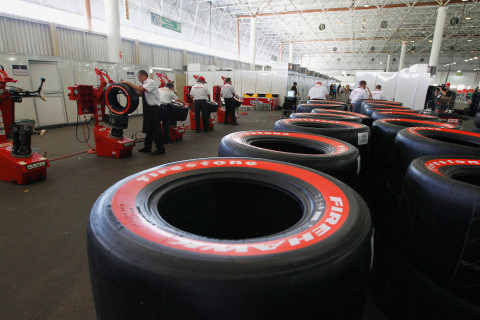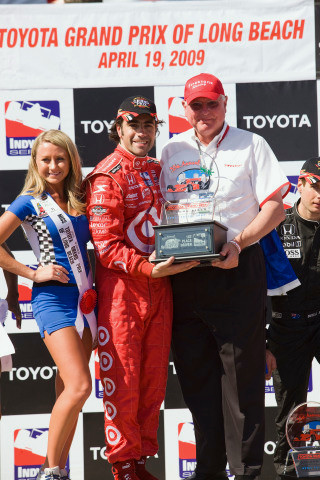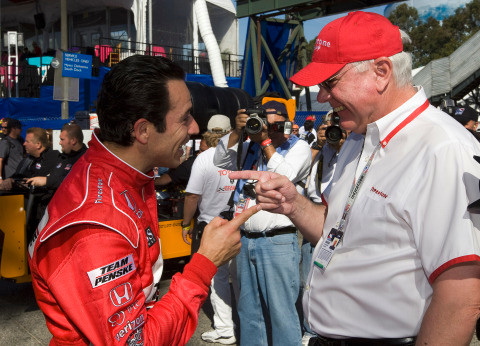The Way It Is/ Why Bridgestone/Firestone continues as IndyCar's tire supplier
by Gordon Kirby Bridgestone/Firestone's US racing boss Al Speyer was delighted when we spoke last Friday following Firestone's surprise announcement that it will continue to be the sole tire supplier to the IZOD IndyCar Series at least through 2013.
Bridgestone/Firestone's US racing boss Al Speyer was delighted when we spoke last Friday following Firestone's surprise announcement that it will continue to be the sole tire supplier to the IZOD IndyCar Series at least through 2013.
"I've been really busy over the last week," Speyer grinned. "It came together more quickly than I thought it would. We've had some late nights this week but it's all been worth it."
Speyer confirmed that IndyCar's team owners were the driving force in convincing Firestone and IndyCar CEO Randy Bernard to keep the company in IndyCar racing.
"We wouldn't be in the position of extending our contract had it not been for the team owners unanimously saying to IndyCar, try to go back to Firestone and keep the program going," Speyer said. "That's what did it. It's the ultimate compliment. We didn't change our minds, nor was it a negotiating tactic. We were out last Friday and then the owners met on Monday and we started talking again.
"Essentially we went back to an offer we had put in place over a month ago and everybody said, okay, let's go with that plan. So we got busy working on the contracts with our management team. There were a couple of lawyers on each side and late on Thursday night we made it happen."

© LAT USA
"It had already been sold a month ago as an offer," Speyer commented. "We said if they'd like to accept the offer we had out there that had previously been approved we were ready to go. Some would probably say we were surprised it hadn't been accepted before. We had agreed to do it and when IndyCar agreed to do it the way we had proposed it just came to niggling over some small details. The community seems to be relieved and that's extra special for us."
The superb reliability and consistency of the company's tires is one of the reasons the team owners insisted to Randy Bernard that he make a new agreement with Bridgestone/Firestone. The company's amazingly dependable tire program strikes a sharp contrast to many others, most notably Goodyear's NASCAR program where tires continue to fail on a regular basis. Continental has also had its problems in the Grand-Am series this year.
Speyer proudly confirmed that Bridgestone/Firestone has not experienced a single tire failure since it started its current Indy car tire program back in 1995.
"That's true," he noted. "Other than something that we traced back to a puncture."
Over the past decade Bridgestone/Firestone emerged as racing's most respected tire brand in both Formula One and Indy cars. The company's annual operating budgets have been reported to be $100 million in F1 and $25 million in IndyCar. Speyer did not dispute those figures.
"I can't comment on the numbers, but I wouldn't take issue with that," he commented.
Speyer pointed out that Firestone will now be able to take full advantage of the Indianapolis Motor Speedway's 100th anniversary celebrations which begin this year and extend through 2016.
"I'm so relieved personally because it frees us up to really celebrate the 100th anniversary with some continuing years to follow," Speyer said. "There's so much we can do with it promotionally and marketing-wise. It's a very special time."
Speyer discussed the primary reasons he believes his company has been so successful in racing.
"I think there are several keys. When we started we had the full support of top management and it was beyond just a racing project. It was a project to revitalize the Firestone brand and to send a message to our dealer base and consumers that even though this big Japanese company Bridgestone had purchased Firestone that Firestone was still very important in the USA market.
"It did more than give us the technical resources that are critical to the success. It gave us the complete company management buy-in to support the program in direct and indirect ways through advertising and so on.
"When we first started we didn't know what to expect. We felt like we could do a pretty good job and as time progressed we got on a very steep learning curve very quickly and worked step by step. We focused on consistency and performance, not just one fast lap.
"I think there was a difference in philosophy of the way we would do testing and the way Goodyear went about their testing. From day one, even in Indy Lights, we were very focused on maintaining the performance of the tires from the first lap to the last lap during a run."
Bridgestone/Firestone's other key component was quality control.

© LAT USA
Speyer emphasized that Bridgestone/Firestone has always concentrated its testing efforts on getting maximum performance over many laps rather than a single hot lap. He believes this was the primary reason the company's tires proved so much better than Goodyear's rubber when they overpowered Goodyear in CART and IRL between 1995-'99.
"I remember having a conversation with Michael Andretti at Fontana when he was still on Goodyears," Speyer recalls. "Our chief engineer Page Mader and I were talking to Michael and he said they were making progress and doing better than they had been. He said, 'We're even doing some long runs now. I ran six or eight laps on a set of tires and they held up really well.' Well, we laughed. We said, 'You could try running them through a full fuel tank.'
"It seemed from what people told us about Goodyear's testing that they would go out and do just a three or four-lap run. I don't know exactly what they did, but when we found a tire we liked we would always do full tank runs from full to empty. We would never leave the track until we had at least run a set through a full tank of fuel and then maybe backed it up with another full tank run. So we took a different approach."
Speyer says Bridgestone/Firestone simply tried to employ a rigorous scientific method.
"In most engineering endeavors you need to be clear on the goal and what you're trying to do," he noted. "Then things fall into place. But if you don't have consistency as a goal and you're not measuring consistency you're never going to get it. If your goal is just to go out and set a record-breaking lap time in each test and you're not looking for or measuring consistency, how can you possibly get there if you don't evaluate it?"
Bridgestone/Firestone's concurrent F1 and IndyCar programs used the same basic approach but there was little technical cross-over between the two programs.
"The consistency angle was something we worked on both in IndyCar and F1, but the two programs were really pretty autonomous," Speyer observed. "The IndyCar program has been centered here in the United States with the production facility in Akron while all the Formula One tires were made in Tokyo with a service location in England. The engineers would get together once a year at an engineering review meeting to share ideas and they would talk to each other throughout the year. The two programs shared some things as far as compounds but were really fairly separate."
But the concept behind both programs was identical.
"The technical and marketing philosophies were very similar," Speyer said. "It goes back to the great management support we've enjoyed. It wasn't only about the development of the tires. It was supporting the series with advertising and promotion and buying signage at the track and bringing our customers out for hospitality so they could see what our tires were capable of.
"We demonstrated that to our customers and gave them some excitement at a sporting event where people like to come out on a Sunday afternoon and maybe forget about what's going on in the rest of the world. It was that total program approach, not just being a tire supplier and standing back and watching cars go around. It was about hitting all the marketing aspects as well. Those were shared traits in both Formula One and IndyCar."
Bridgestone/Firestone employs around 100 people in its American racing division.
"We were larger when we were doing both IndyCar and ChampCar," Speyer said. "We were probably thirty percent larger with maybe 130 people in total in both production and field service. We've probably had 400-500 people come through our domestic Indy car program since we started.

© LAT USA
Speyer reminisced about 1995 and Bridgestone/Firestone's first year back in Indy car racing after Firestone's 1976 pull-out. Both Scott Goodyear and Scott Pruett led that year's Indy 500 on Firestones and Pruett scored the revitalized company's first victory for its new program in that summer's Michigan 500.
"Even in 1995 when we came back to Indy the tires were really good," Speyer recalls. "We had Scott Goodyear on the front row and we had eight cars in the field. Both Goodyear and Scott Pruett had a shot at winning that race and it wasn't because of tires that they didn't. Pruett had a little slip and Goodyear passed the pace car. Prior to that they were almost half a lap ahead of the rest of the field, but nobody really paid that much attention. It was amazing to me.
"But when Pruett beat Al Unser Jr. in the Marlboro 500 at Michigan I remember Larry Curry describing to me how Al Jr. drove Pruett higher and higher up into the gray, like you're supposed to do. But Pruett kept his foot in it and the tires stuck and he won. Larry Curry said, 'That was tires. That was all down to the tires.' The next day my phone started ringing off the hook."
When Firestone-shod Andre Ribeiro's Reynard-Honda drove around Michael Andretti's Goodyear-tired Lola-Ford/Cosworth on the New Hampshire Speedway later that summer and pulled away to win easily everyone got the message that Firestone was the tire to have.
"I'll never forget Loudon," Speyer recalled. "Here was this rookie Andre Ribeiro who was making all kinds of mistakes trying to get around the wiley veteran Michael Andretti. Ribeiro went high and almost slid into the wall and then he tried low and got cut off. Michael was trying everything to hold him back and Ribeiro finally got around him and just sailed off into the distance. He just took off. After that my phone really started ringing off the hook!"
All of Goodyear's long-standing top teams--Penske's Penske-Mercedes, Newman/Haas's Swift-Ford/Cosworths and All American Racers' Eagle-Toyotas--struggled and fell toward the back of the field. Each of them had individual challenges to deal with but the common thread was all of them were on Goodyears.
"We had five full-time cars in '95, the first year," Speyer recalled. "It went from five to fifteen to twenty cars. By that time Goodyear only had about six left and it was for the most part over. We made a very strategic management decision that we were not going to buy teams. We would spend healthy amounts of money on technology, but we were not going to spend money to get teams to switch and we didn't do that. They came because of the product."
Penske stopped building his own cars and engines and switched to racing Reynard-Hondas in CART, then Dallaras and G/Forces in the IRL. After Paul Tracy scored Penske's 99th win in 1997 Roger's team went through a fallow period, failing to win any races in 1996, '98 and '99. It wasn't until Penske made a wholesale change for 2000 to Reynard-Hondas on Firestone tires that Gil de Ferran was able to bring home Roger's 100th Indy car win.
"Roger said on several different occasions that the tires were a big part of the team's turnaround," Speyer grinned. "They carried those 100 victory caps around the world several times looking for that 100th victory. They switched tires and they got it. So it was nirvana for us--tire nirvana. We were racing well on the track and selling tires and everyone in the company was excited. I'm not sure that we'll ever repeat that in quite the same way."
Finally, Speyer and Bridgestone/Firestone remain big proponents of the Delta Wing. Designer Ben Bowlby is continuing to search for the financial backing to build and test a prototype Delta Wing and Speyer hopes to see it happen.
"We'll have to see what develops and have further conversations here internally. But there are some things going on that could potentially find some funding for the Delta Wing that's related to government initiatives at both the Department of Energy and Department of Transportation. It's based on the efficiency of the Delta Wing concept with half the weight and half the drag and half the horsepower of the current cars for the same performance. It's very relevant as we increasingly look at our dependence on normal petroleum and we're evaluating alternative energy sources like electric and hybrids.
"I certainly have a very keen personal interest in the Delta Wing and how it applies to our energy independence that we all want to get to. But we've got the cart a little bit ahead of the horse now because we've got to go back and internally discuss what may make sense or not business-wise with the Delta Wing concept. If it can't be an Indy car maybe it can race someplace else."
It's a great boost for IndyCar that Firestone will continue to supply the IZOD IndyCar Series with tires for at least the next three years. But like most of us, Bridgestone/Firestone is concerned about where racing is headed and whether it will embrace future technology or not. The 2012 Dallara is a very small step in that direction but more and more people are beginning to realize that the Delta Wing defines the future.
Auto Racing ~ Gordon Kirby
Copyright 2011 ~ All Rights Reserved
Copyright 2011 ~ All Rights Reserved
Top of Page